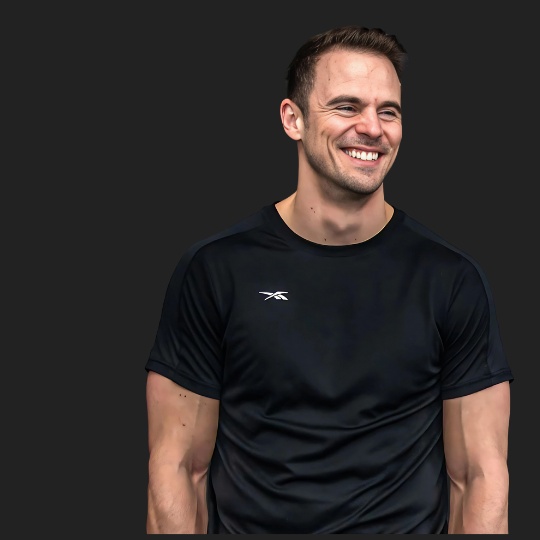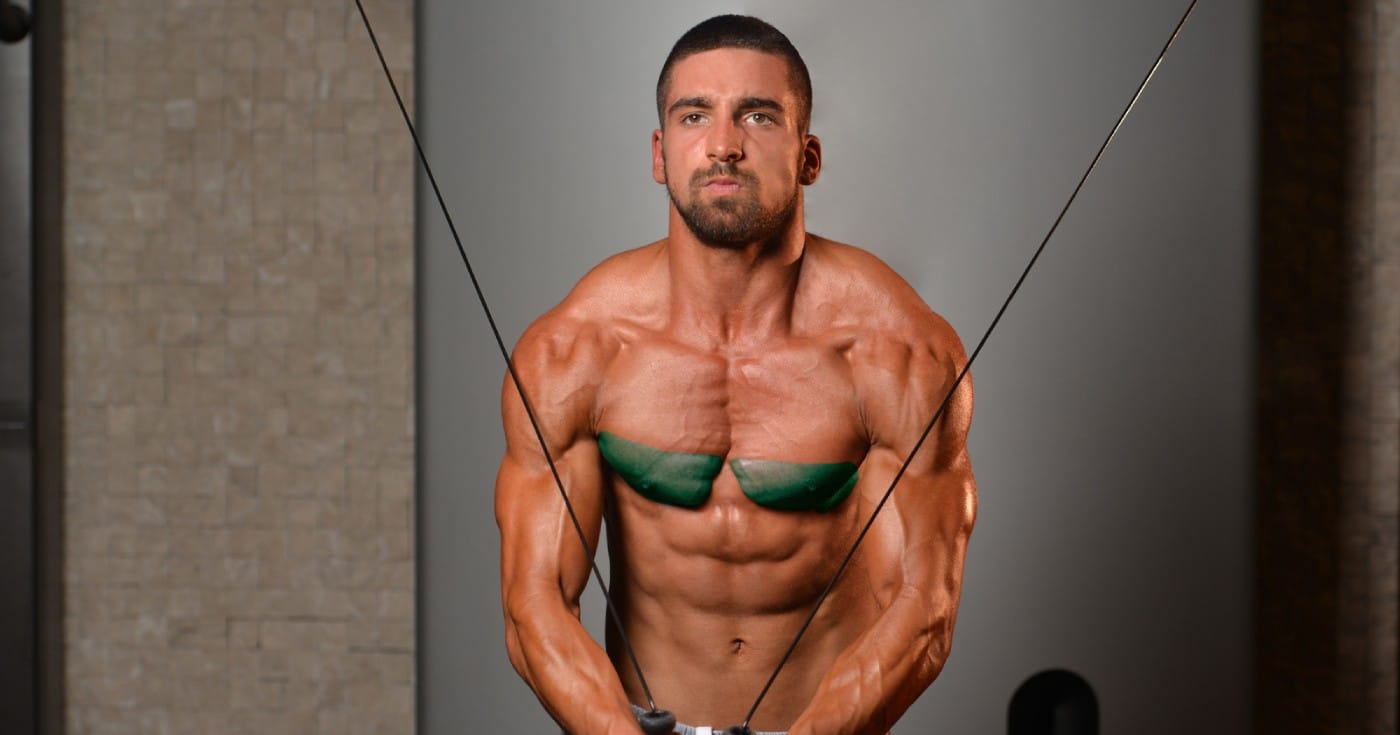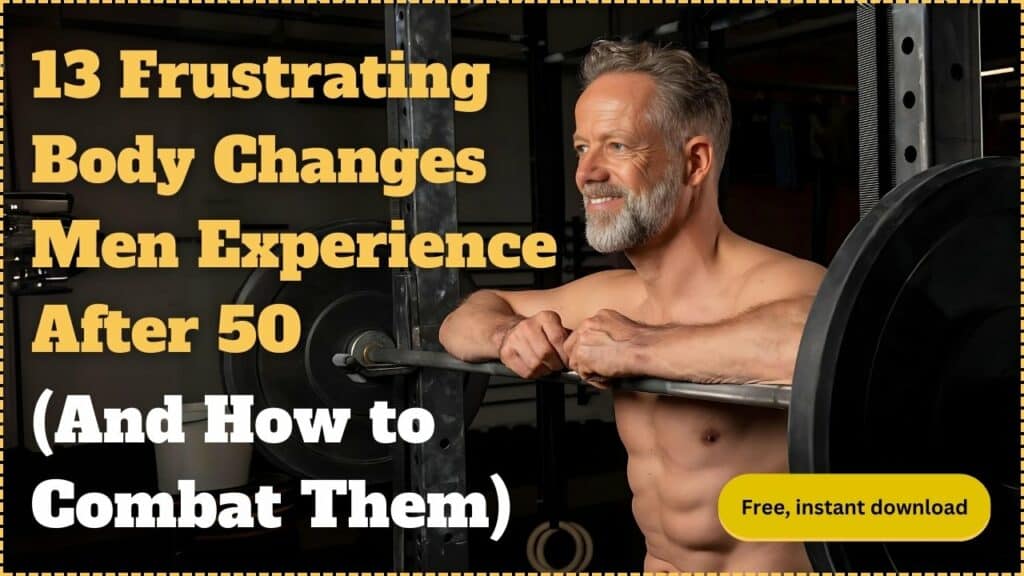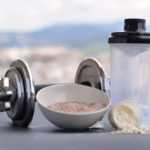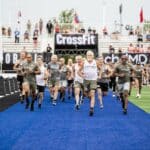Unlock the secrets to a chiseled lower chest with our expert guide on the best lower chest training exercises and workouts.
Discover why targeting this often-neglected area is key to achieving a balanced and visually striking chest. Learn how specific exercises like decline presses and dips can transform your lower chest, enhancing both its appearance and strength.
Whether you’re seeking to improve your physique or boost your functional strength, our tips on angles, positions, and targeted movements promise a comprehensive approach to chest development.
Jump to:
- Can You Actually Isolate the Lower Chest?
- Exercises to Target the Lower Chest
- Complete Workouts for Lower Chest Development
- How to Warm-up Your Lower Chest Before Training
- Training Strategies and Tips
- Addressing Common Issues: Why My Lower Chest is Not Growing?
- Benefits of Training Your Lower Chest
- Understanding Chest Muscles
Can You Actually Isolate the Lower Chest?
While no exercise can completely isolate any one part of the pectoral muscle due to its interconnected nature, certain movements can emphasize the lower chest more effectively.
By adjusting angles and positions, it’s possible to place greater stress on the lower chest fibers, leading to more pronounced development in this area.
Exercises like decline presses and dips, when performed with proper technique, can significantly engage the lower chest, enhancing its appearance and strength.
This targeted approach allows for a comprehensive chest workout that addresses both aesthetic and functional goals, ensuring balanced development across the entire pectoral area.
Exercises to Target the Lower Chest
Targeting the lower chest can significantly enhance your chest’s overall appearance and functionality. Below are detailed exercises specifically designed to focus on this area.
Decline Bench Press
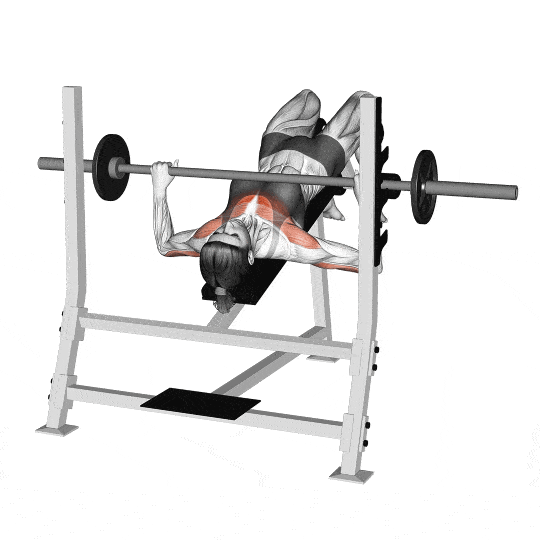
How to do it:
- Secure your legs at the end of the decline bench and lie down with your eyes under the barbell.
- Grasp the bar with a medium-width grip, un-rack it, and hold it straight over your chest with arms locked.
- Inhale and lower the bar slowly to your chest, keeping your elbows close to your body.
- After a brief pause, push the bar back to the starting position by extending your arms, exhaling as you perform this movement.
Muscles Worked/Benefits: The bench press primarily targets the lower pectoral muscles, offering a concentrated way to build mass and strength in the lower chest area. Secondary muscles engaged include the triceps and deltoids, making it a compound movement with broad benefits.
Equipment Needed: A decline bench and a barbell or dumbbells.
Chest Dips (and Variations)
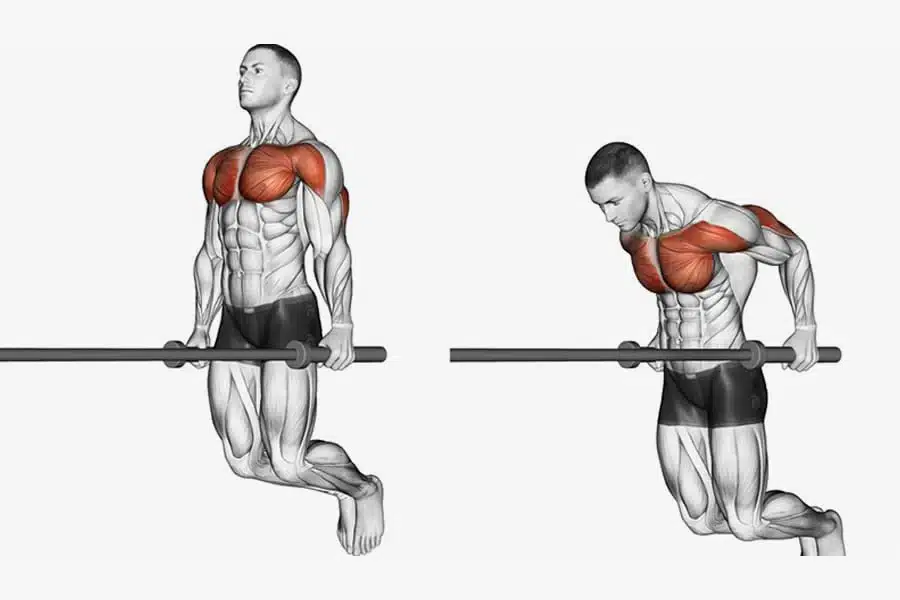
Standard Chest Dip:
How to Do It:
- Grip the parallel bars and lift your body until your arms are straight.
- Lean forward slightly, keeping your elbows flared out.
- Lower your body until your shoulders are slightly below your elbows or as low as comfortably possible.
- Push yourself back up to the starting position, focusing on using your chest muscles.
Muscles Worked/Benefits: This variation targets the lower chest and triceps, enhancing chest definition and increasing upper body strength.
Equipment Needed: Parallel bars or a dip station.
Dip Plus:
Adds an extra push at the top of the movement to engage the serratus anterior, further stabilizing the shoulder and chest.
Straight Bar Dip:
Performed on a straight bar, this variation challenges your grip and balance, emphasizing the lower chest and core.
Decline Cable Dip:
By using a cable machine and a decline bench, this innovative approach allows for constant tension on the lower chest, maximizing muscle activation.
For each variation:
- Ensure your body leans forward to shift the focus onto the lower chest.
- Adjust your grip and elbow position to find the angle that best targets the lower chest.
- Use controlled movements to maximize muscle engagement and minimize injury risk.
Cable Exercises
Cable exercises are versatile and effective for targeting the lower chest, offering constant tension throughout the movement. Here are several key exercises:
Cable Crossover
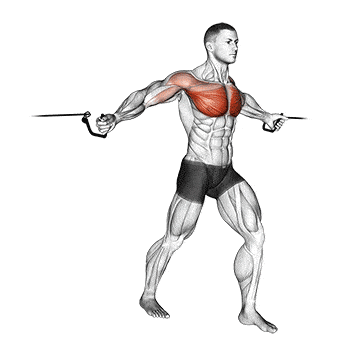
Steps to Perform:
- Set the pulleys to the highest position.
- Stand in the middle of the machine, slightly forward, holding the handles with palms facing down.
- With a slight bend in your elbows, bring your hands together in a wide arc until they meet in front of your hips.
- Slowly return to the starting position in a controlled motion.
Muscles Worked/Benefits: Targets the lower chest muscles, improving muscle definition and enhancing the chest’s overall appearance. It also engages the shoulders and triceps.
Equipment Needed: Dual cable machine.
Jackhammer Pushdown
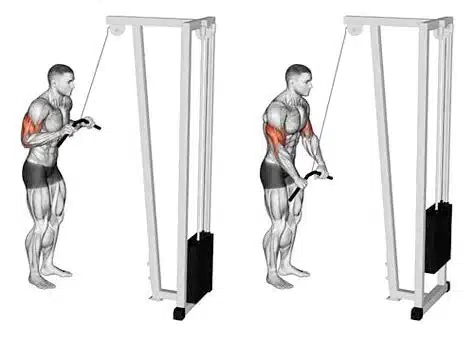
Steps to Perform:
- Attach a straight bar to a high pulley.
- Grasp the bar with an overhand grip, elbows close to your sides.
- Push the bar down towards your thighs, leaning forward slightly as you extend your arms.
- Return to the starting position with control.
Muscles Worked/Benefits: This exercise focuses on the lower chest and triceps, offering a unique angle of resistance.
Equipment Needed: Cable machine with a straight bar attachment.
Standing Cable LC Press
Steps to Perform:
- Set the pulleys to the lowest position and choose a moderate weight.
- Stand in the center, holding the handles with your palms facing down.
- Press the handles up and together in a sweeping arc, extending your arms fully in front of your chest.
- Return to the starting position with control.
Muscles Worked/Benefits: Primarily targets the lower chest, with additional emphasis on the shoulders and triceps.
Equipment Needed: Dual cable machine.
Kneeling X Press
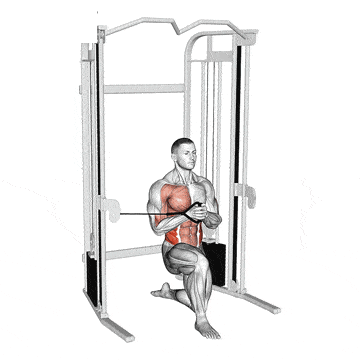
Steps to Perform:
- Set the pulleys to a high position and kneel between them, facing away from the machine.
- Hold the handles with your arms extended and crossed over each other in an “X” formation.
- Press the handles down and out to your sides, uncrossing your arms until they are fully extended at hip level.
- Slowly return to the starting position.
Muscles Worked/Benefits: This exercise effectively isolates the lower chest while engaging the core due to the kneeling position.
Equipment Needed: Dual cable machine.
D2 Flexion Crossover
Steps to Perform:
- Attach a handle to the low pulley.
- Stand with your side to the machine, gripping the handle with the hand farthest from the machine.
- With a straight arm, sweep the handle up and across your body to shoulder height, rotating your torso as you move.
- Return to the starting position with control.
Muscles Worked/Benefits: Targets the lower chest and improves shoulder mobility.
Equipment Needed: Single cable machine.
High Cable Fly
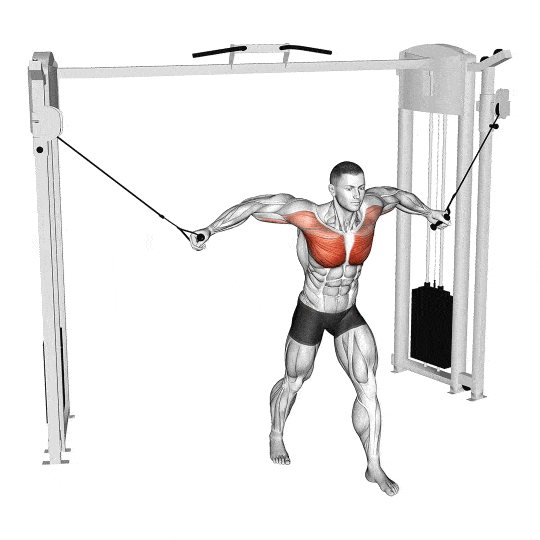
Steps to Perform:
- Set the pulleys above head height and select a moderate weight.
- Stand in the center with a handle in each hand, palms facing forward.
- With a slight bend in your elbows, bring your hands down and together in front of your waist.
- Slowly return to the starting position, allowing your chest to stretch.
Muscles Worked/Benefits: Focuses on the lower chest, with the high angle providing a unique stretch and contraction.
Equipment Needed: Dual cable machine.
Push-Up Variations
Push-ups are a versatile bodyweight exercise that can be modified to target the lower chest specifically.
Incline Push-Up
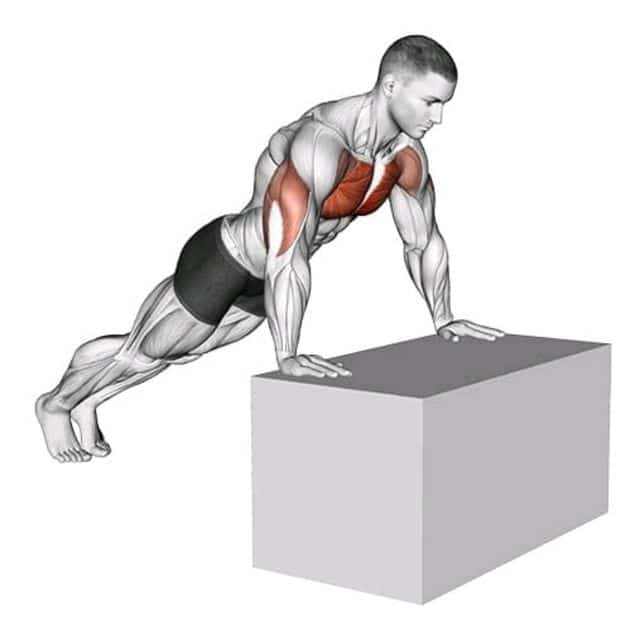
Steps to Perform:
- Place your hands on the edge of the raised surface, slightly wider than shoulder-width apart.
- Step your feet back to form a straight line from your head to your heels.
- Lower your chest towards the surface, keeping your elbows close to your body.
- Push through your hands to return to the starting position.
Muscles Worked/Benefits: Primarily targets the lower chest and triceps, with the incline position placing more emphasis on the lower chest.
Incline Twisting Push-Up
Steps to Perform:
- Start in a standard push-up position.
- As you lower yourself, twist your torso and lift one arm off the ground, reaching towards the opposite side.
- Return to the push-up position and repeat on the other side.
Muscles Worked/Benefits: Adds rotation to target the lower chest and obliques, enhancing core stability and chest strength.
Decline Push-Up
Steps to Perform:
- Place your feet on the raised surface and hands on the ground, slightly wider than shoulder-width apart.
- Lower your body towards the ground by bending your elbows, keeping your body straight.
- Push through your hands to return to the starting position.
Muscles Worked/Benefits: This variation places more emphasis on the lower chest and shoulders, increasing the intensity of the standard push-up.
Stability Ball Push-Up
Steps to Perform:
- Place your hands on the stability ball, slightly wider than shoulder-width apart.
- Extend your legs behind you, forming a straight line with your body.
- Lower your chest towards the ball, keeping your elbows close to your body.
- Push yourself back up to the starting position.
Muscles Worked/Benefits: Targets the lower chest while engaging the core and improving balance.
Equipment Needed: Stability ball.
Dumbbell and Machine Exercises
These exercises provide a range of options for targeting the lower chest, utilizing different equipment to engage the muscles effectively.
Dumbbell Chest Press
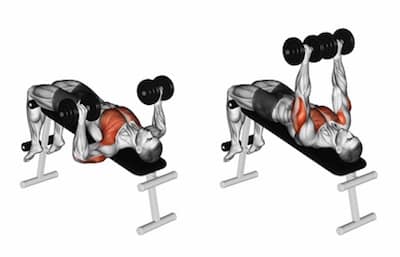
Steps to Perform:
- Lie on a bench with a dumbbell in each hand, palms facing forward.
- Press the dumbbells up until your arms are extended above your chest.
- Lower them back down slowly to the starting position.
Muscles Worked/Benefits: Targets the pectoral muscles, with emphasis on the lower chest when performed on a decline bench. It also engages the triceps and shoulders.
Equipment Needed: Dumbbells and a bench (preferably adjustable for decline positions).
Machine Chest Press
Steps to Perform:
- Adjust the seat so the handles are at chest level.
- Grip the handles and press forward until your arms are extended.
- Slowly return to the starting position.
Muscles Worked/Benefits: Provides a stable way to isolate the chest muscles, particularly beneficial for beginners or those looking to focus on form.
Equipment Needed: Chest press machine.
Cable Chest Flyes
Steps to Perform:
- Set the pulleys to a low position for lower chest focus.
- Hold the handles with your palms facing in, and step forward in a staggered stance.
- With a slight bend in your elbows, bring your hands together in a wide arc until they meet in front of your body.
- Slowly return to the starting position.
Muscles Worked/Benefits: Targets the chest muscles, enhancing muscle definition and strength across the chest, including the lower regions when adjusted appropriately.
Equipment Needed: Dual cable machine.
Dumbbell Chest Fly
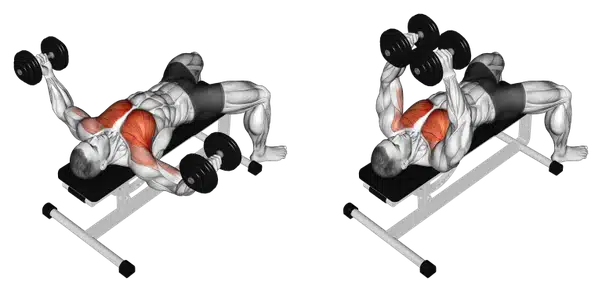
Steps to Perform:
- Lie on a bench with a dumbbell in each hand, arms extended above your chest.
- With a slight bend in your elbows, lower the dumbbells out to the sides in a wide arc.
- Bring them back up to the starting position.
Muscles Worked/Benefits: Isolates the chest muscles, improving muscle tone and definition. Performing this on a decline bench targets the lower chest.
Equipment Needed: Dumbbells and a bench.
Machine Chest Fly
Steps to Perform:
- Adjust the seat so the handles are at chest level.
- Grip the handles and bring them together in a smooth, controlled motion.
- Slowly return to the starting position.
Muscles Worked/Benefits: Specifically targets the chest muscles, providing a controlled movement that is easy to perform correctly.
Equipment Needed: Chest fly machine.
Dumbbell Pullover
Steps to Perform:
- Lie perpendicular on a bench with only your upper back supported, feet flat on the ground.
- Hold a dumbbell with both hands above your chest, arms extended.
- Lower the dumbbell back and over your head in an arc, keeping your arms straight.
- Pull the dumbbell back to the starting position.
Muscles Worked/Benefits: Targets the lower chest, lats, and triceps, offering a unique stretch and contraction across the chest.
Equipment Needed: Dumbbell and a bench.
Decline Dumbbell Chest Fly
Steps to Perform:
- Lie on a decline bench with a dumbbell in each hand, arms extended above your chest.
- With a slight bend in your elbows, lower the dumbbells out to the sides in a wide arc.
- Bring them back up to the starting position.
Muscles Worked/Benefits: Focuses on the lower chest, enhancing muscle separation and definition.
Equipment Needed: Dumbbells and a decline bench.
Dumbbell Hip Extension Floor Press
Steps to Perform:
- Lie on the floor with knees bent and a dumbbell in each hand.
- Lift your hips towards the ceiling, engaging your glutes.
- Press the dumbbells up until your arms are fully extended, then lower them back to your chest.
Muscles Worked/Benefits: Targets the lower chest and triceps while engaging the core and glutes through hip extension.
Equipment Needed: Dumbbells.
Complete Workouts for Lower Chest Development
Crafting a comprehensive workout regimen that includes focused lower chest development is essential for achieving a well-rounded and aesthetically pleasing chest.
Below, find examples of workouts that target the full chest with an emphasis on the lower region, alongside recommendations for sets, reps, and how to properly warm up.
Full Chest Workout Example (Including Lower Chest)
- Warm-Up: 5-10 minutes of light cardio (jogging, jumping jacks) followed by dynamic chest stretches.
- Flat Bench Press: 4 sets of 8-12 reps.
- Incline Dumbbell Press: 3 sets of 8-12 reps.
- Decline Bench Press: 4 sets of 8-12 reps to target the lower chest.
- Cable Crossover (Low Pulley setting for lower chest focus): 3 sets of 12-15 reps.
- Dips with a slight forward lean: 3 sets to failure for deep lower chest engagement.
- Cool Down: Stretching exercises focusing on the chest and shoulders.
The Ultimate Lower Chest Workout: Exercises for Definition + Strength
- Decline Dumbbell Fly: 4 sets of 10-12 reps.
- Cable Crossover (from high to low): 4 sets of 12-15 reps, focusing on squeezing at the bottom.
- Dips (Chest Version): 4 sets to failure, leaning forward to emphasize the lower chest.
- Decline Cable Press: 3 sets of 10-12 reps, ensuring a full range of motion.
- Push-Up Variations (Decline Push-Ups): 3 sets to failure, adjusting the feet elevation to increase intensity.
Recommended Sets, Reps, and Weight Percentages for Strength Gains
- Strength Focus: For building strength, focus on 4-6 sets of 4-8 reps with heavier weights (75%-85% of your 1RM).
- Hypertrophy Focus: To encourage muscle growth, aim for 3-5 sets of 8-12 reps with moderate weights (65%-75% of your 1RM).
- Endurance and Definition: For endurance and definition, opt for 2-4 sets of 12-15+ reps with lighter weights (50%-65% of your 1RM).
Always allow for at least 48 hours of recovery for the muscle group before targeting it again to ensure proper healing and growth.
Workout Example for Lower Chest
- Warm-Up: Dynamic chest stretches and light cardio.
- Decline Bench Press: 4 sets of 6-8 reps.
- Dumbbell Pullovers: 3 sets of 8-10 reps.
- Cable Flyes (set at lower pulley): 4 sets of 10-12 reps, focusing on the stretch and contraction of the lower chest.
- Dips: 3 sets to failure, focusing on depth and form.
How to Warm-up Your Lower Chest Before Training
Warming up the lower chest, and the entire pectoral muscle group, is crucial to prevent injuries and maximize performance.
- Cardio Warm-Up: Start with 5-10 minutes of light cardio to increase heart rate and blood flow to the muscles.
- Dynamic Stretching: Perform arm swings, arm circles, and chest openers to enhance flexibility and reduce muscle stiffness.
- Activation Exercises: Use light weights or resistance bands to perform exercises such as chest presses and flyes with a focus on the lower chest. Aim for high reps (15-20) to fully activate the muscles without inducing fatigue.
- Progressive Overload: Begin your workout with lighter weights, gradually increasing the load to prepare the muscles for heavier lifting.
Training Strategies and Tips
Maximizing the development of the lower chest requires a strategic approach to training. Below are targeted strategies and tips to enhance lower chest growth effectively.
How to Effectively Train the Lower Chest
- Frequency: Aim for 2-3 chest-focused sessions per week, allowing sufficient recovery time.
- Intensity: Incorporate a mix of heavy lifting (for strength) and moderate to high reps (for hypertrophy).
- Variety: Rotate exercises to target the lower chest from different angles and prevent plateaus.
Sets and Reps Guidance
- Strength Building: 4-6 sets of 4-8 reps at 75%-85% of your 1RM.
- Muscle Growth: 3-5 sets of 8-12 reps at 65%-75% of your 1RM.
- Muscle Endurance and Definition: 2-4 sets of 12-15+ reps at 50%-65% of your 1RM.
Adjust sets and reps based on your goals, ensuring you progressively overload the muscles over time.
Addressing Common Issues: Why My Lower Chest is Not Growing?
- Plateaus in Training: Vary your exercises, angles, and rep schemes regularly to avoid adaptation and stimulate growth.
- Insufficient Intensity: Ensure you’re lifting heavy enough weights to challenge your muscles within the recommended rep ranges.
- Inadequate Recovery: Overtraining can hinder growth. Ensure you’re allowing enough recovery time and focusing on nutrition and sleep.
- Poor Form: Incorrect technique can shift the focus away from the lower chest. Consider working with a trainer to improve your form.
Benefits of Training Your Lower Chest
Improved Posture: Strong lower chest muscles contribute to better shoulder alignment and upper body posture. This adjustment reduces the risk of back pain and other posture-related issues.
Better Breathing: A well-developed chest, including the lower region, supports respiratory function. It allows for more efficient lung expansion, facilitating improved oxygen intake during exercise and daily activities.
Enhanced Athletic Performance: Training the lower chest enhances overall upper body strength, contributing to better performance in sports and activities requiring pushing, pulling, and lifting motions.
Understanding Chest Muscles
Grasping the anatomy of the chest muscles is fundamental for effective training, especially when aiming to target specific areas like the lower chest. The chest, or pectoral area, comprises several key muscles that work together to facilitate a broad range of upper body movements.
Anatomy of the Chest
The chest’s muscular structure is primarily made up of the pectoralis major and pectoralis minor, alongside other muscles that play supportive roles in chest function and movement.
- Pectoralis Major: This is the largest chest muscle, covering the majority of the chest area. It’s responsible for movements such as flexing, rotating, and adducting the humerus (the bone of the upper arm).
- Pectoralis Minor: Situated beneath the pectoralis major, this smaller muscle assists in movements of the shoulder blade, including its depression and protraction.
Key Areas of the Pectoral Muscle
The pectoralis major can be further subdivided into different areas based on the direction of the muscle fibers and their points of attachment:
- Upper Chest (Clavicular Head): This area is targeted by exercises that involve pressing from lower to higher angles.
- Middle Chest (Sternal Head): The bulk of chest exercises target this central area, focusing on flat and incline movements.
- Lower Chest (Costal Head): This region is emphasized through exercises involving downward angles and movements that require pushing away from the body.
References
- Solari, F., & Burns, B. (2020). Anatomy, Thorax, Pectoralis Major Major. PubMed; StatPearls Publishing. https://www.ncbi.nlm.nih.gov/books/NBK525991/
- Lauver, J. D., Cayot, T. E., & Scheuermann, B. W. (2015). Influence of bench angle on upper extremity muscular activation during bench press exercise. European Journal of Sport Science, 16(3), 309–316. https://doi.org/10.1080/17461391.2015.1022605
- Rodríguez-Ridao, D., Antequera-Vique, J. A., Martín-Fuentes, I., & Muyor, J. M. (2020). Effect of Five Bench Inclinations on the Electromyographic Activity of the Pectoralis Major, Anterior Deltoid, and Triceps Brachii during the Bench Press Exercise. International Journal of Environmental Research and Public Health, 17(19), 7339. https://doi.org/10.3390/ijerph17197339
- Coratella, G., Tornatore, G., Longo, S., Esposito, F., & Cè, E. (2019). Specific prime movers’ excitation during free-weight bench press variations and chest press machine in competitive bodybuilders. European Journal of Sport Science, 1–9. https://doi.org/10.1080/17461391.2019.1655101

